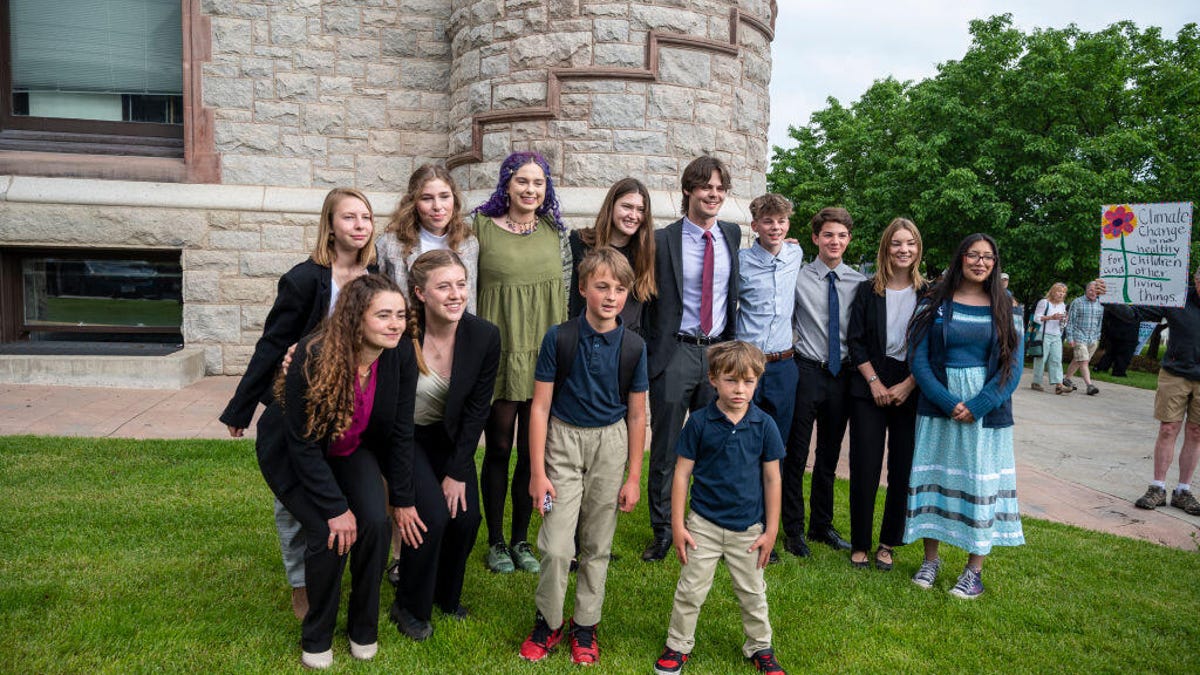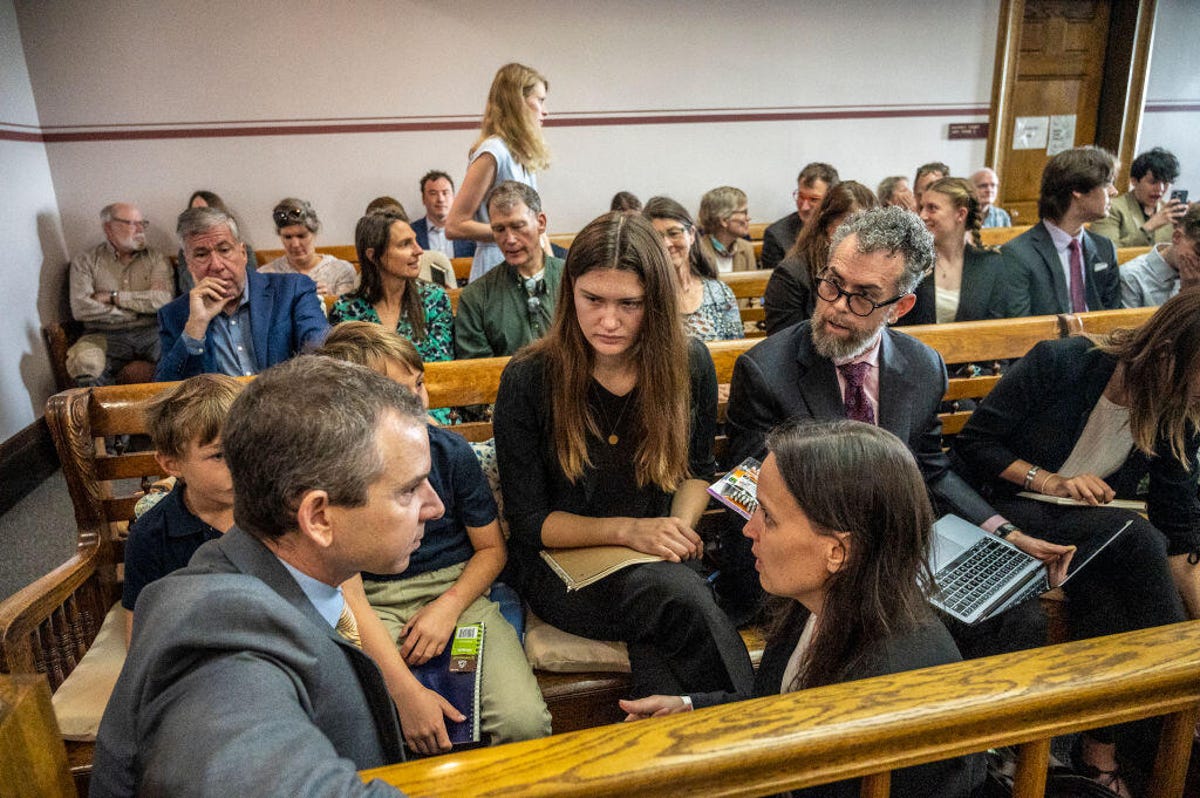Technologies
Gen Z Prevailed in a Climate Lawsuit. More Youth Trials Are on the Way
Young people fighting for a better future for the planet are beginning to discover that the law is on their side.

For two weeks in June, a Montana court heard from young people – 16 in total, ages 5 to 22 – and their families about the toll of extreme weather events caused by climate change on their health and other aspects of their lives.
They argued that the state of Montana had violated their constitutional rights to, among other things, a clean and healthful environment, by supporting a fossil fuel energy system and by failing to take action that would protect them against the harmful effects of climate change.
On Monday, after a two-month wait, they learned that they’d won.
In a landmark victory, Judge Kathy Seeley ruled in their favor, concluding in a 103-page decision that they’d proved significant injuries had occurred. Not only that, the decision in Held v. Montana said the case, launched in 2020, had shown that the Montana state government had been instrumental in causing these injuries and would be required to make changes to its conduct.
It’s a ruling that will likely have repercussions well beyond Montana’s state lines.
«We set the precedent not only for the United States, but for the world,» said 18-year-old Kian Tanner from Bigfork, Montana, in a statement.
It’s also another sign that Generation Z is finding new and forceful ways to make itself heard on climate issues. Gen Zers are using legal systems in the US and other countries to try to stem the damage being done by the burning of fossil fuels and the resulting greenhouse gases and to hold the responsible parties accountable.
Most young people are encouraged to avoid brushes with the legal system, but the plaintiffs in Montana, underpinned by legal team Our Children’s Trust, join a growing number of youth from around the world who are wielding the law to pressure governments into taking more radical action on climate.
Now that we’re regularly facing the impacts of human-caused climate change in our daily lives in the form of extreme weather events or breathing in smoke from forest fires, it’s easy to feel overwhelmed or powerless. But there are things we can do: recycle, cut down on car use, install solar panels and heat pumps, vote eco-friendly and support environmental campaigns. And litigate.
The Montana plaintiffs didn’t seek financial damages for the harms they’ve suffered due to climate change. Instead they wanted to change the current system – they sued over a law that prohibited the state from considering greenhouse gas emissions or climate change impacts when greenlighting fossil fuel projects.
«Young people are turning to court because they know that this isn’t about just the consumer choices that people make,» said Andrea Rodgers, senior litigation attorney at Our Children’s Trust, in an interview ahead of the verdict being issued. «This is about how we get energy, how we transfer goods, those kinds of systemic issues that governments really control.»
Monday’s decision is a game-changer, said Julia Olson, chief legal counsel and executive director with Our Children’s Trust, in a statement. «More rulings like this will certainly come.»
Here’s a look at some other prominent climate cases being driven by young people.
Kids vs. climate change
Way back in 2015, 21 young people filed a constitutional climate lawsuit against the federal government. They asserted that through government actions that cause climate change, it has violated the youngest generation’s constitutional rights to life, liberty and property.
Known as Juliana v. The United States, the federal case (also backed by Our Children’s Trust) was delayed by opposition from the Department of Justice under the Trump administration. Then, in June of this year, US District Court Judge Ann Aiken ruled that it can proceed to trial. Now the organizations supporting the young plaintiffs are asking the Biden administration not to delay the trial further.
«It’s long past time for the Department of Justice to end its opposition to the Juliana plaintiffs and youth climate justice,» said Zanagee Artis, founder and executive director of youth activist nonprofit Zero Hour. «Young Americans have the right to be heard by our nation’s courts, the branch of our government that has a duty to protect our constitutional right to a livable planet.»
For many years, courts were reluctant to hear and decide the merits of climate cases, said Rodgers. Just getting the Montana case to trial was a victory that signified «a real moment of change,» she added, that’s paved the way for trials to proceed both in the Juliana case and in another case that Our Children’s Trust is pursuing, in Hawaii.
Rodgers says the courts are now opening their doors to American youth because of the increasingly real and visceral impacts of climate change. «That does make a difference,» she said, «because it takes the injuries that the youth are experiencing … from being hypothetical to being real and tangible.»
Youth victories in and out of court
In the climate justice movement, young activists are key players in moving the needle on key issues, through protests, direct action and dialogues with politicians. But the combination of youth activism and legal action can be an especially potent mix.
In 2018, Indigenous climate activist and environmental engineer Yurshell Rodriguez, now 28, was one of 25 young people who successfully sued the government of Colombia for failing to reduce deforestation of the Amazon rainforest, thereby threatening their fundamental rights to a healthy environment, life, health, food and water. The lawsuit resulted in an intergenerational pact that meant the government had to consult with the plaintiffs, the affected communities and scientists to reduce deforestation in the Amazon.
«Activism sends a powerful message that the younger generation refuses to inherit a world plagued by environmental degradation and the consequences of inaction,» Rodriguez said in an interview. «But through lawsuits, we are raising awareness, mobilizing public support and challenging the status quo, compelling governments to prioritize sustainable policies, reduce carbon emissions and protect the planet for future generations.»

Young plaintiffs shouldn’t get discouraged if a judge rules against them, Rodriguez says – the awareness and public support a legal case can drive is also a positive result, which can in turn force the government’s hand.
In Europe in 2021, the People’s Climate Case, brought by 10 families including their children, was ultimately ruled inadmissible on a technicality by the Court of Justice of the European Union, but it spurred the EU to ramp up its fossil fuel reduction targets. «It’s all about kind of embarrassing the government into action,» said British human rights barrister Marc Willers.
There are always benefits to having young people tell their stories in open court alongside expert evidence and see states fail to defend their inaction, says Rodgers. «Even though there have been defeats and decisions that we consider to be unfavorable, it is still moving the ball forward.»
How to sue your government
No matter your age, it can be a «daunting prospect» to take on the state, even more so a fossil fuel giant that will throw everything it has at fighting your claim and attempting to discredit you, said Willers, who’s worked on a number of high-profile international environmental cases.
To bring a legal case, you’re going to need the support of sympathetic lawyers and an NGO or grassroots climate organization that knows the system and provides the necessary support, Willers said. He also advises forming a group, as the young people in the Montana and Juliana cases did, rather than going it alone, and finding a legal team that’s willing to spend time getting to understand your perspective.
In his work, Willers said, he’s found there are «real benefits to having young people involved in the litigation.» Children and youth can bring energy, positivity and unique viewpoints into the courtroom as representations of the future generations inheriting the Earth. They’re also often more knowledgeable about the issues than people give them credit for.

Young people often have a sophisticated understanding of the science combined with a sense of frustration and impatience, said Rodgers. She cited the example of a climate activist who achieved worldwide renown in her teens. «Greta Thunberg probably expresses that most prominently, but she’s simply expressing the feelings of youth universally, in my experience.»
Mounting global pressure
There’s no sign of youth-led climate litigation slowing down, what with legal wins in Colombia and Montana; the first lawsuit involving individuals versus the federal government underway in the US; and a major trial due to kick off in France this September based on six children and young adults suing 32 European countries.
As in the Montana case, the plaintiffs in that European case, all from Portugal, aren’t seeking financial damages – even though they’re entitled to. Instead, they’re pursuing a legally binding decision from the European Court of Human Rights that would require the countries to take action against climate change.
The more these cases occur around the world, the more they build momentum and make the voices of youth harder to ignore, said Rodgers. «What’s really cool is seeing these young people inspiring one another and building off of one another’s work.»
Such cases are strengthened by the fast-evolving field of attribution science, which can increasingly draw direct lines between specific emissions and the harms they’re causing. Lawsuits lodged by individuals against companies or institutions will only continue to get stronger and more frequent as our understanding of the science of climate change improves, Willers predicts.
When taking the legal route, progress can be painfully slow, as the young people in the now 8-year-old Juliana case have discovered. Some of them are no longer the kids they were at the time the suit was filed. But with children more aware than ever of growing up in a world threatened by climate change, there will be no shortage of young people willing to fight for their rights.
Rodriguez, who’s been there herself, is supportive of other young people considering demanding accountability and pushing for new measures through legal action. She encourages them to see themselves as «custodians of the future» who can leverage their voices and rights to hold those in power responsible for safeguarding the environment.
«To all the young people I will just say: Our actions inspire hope and serve as a reminder that collective efforts are essential in tackling the complex challenges of this climate crisis,» she says. «Be the change you want to see.»
Technologies
The Sequel to Subway Surfers Is Launching in February, and You Can Preregister Now
Subway Surfers was the most downloaded game of the 2010s, so the sequel has some big shoes to fill.

Of all the mobile games ever released, none of them is as popular as Subway Surfers. The iconic endless runner has put up 4.5 billion downloads since its initial release in 2012. After 14 years of unprecedented success, developer SYBO Games is ready to turn the page with the release of a sequel, Subway Surfers City.
SYBO says the game is set to launch on Feb. 26, and it’s available for preregistration on Google Play and iOS right now. SYBO also released a cinematic trailer showing off some new characters and environments.
The sequel features a new metropolis location with four districts to play through at launch, including The Docks, Southline, Sunrise Blvd and Delorean Park, along with four new characters. SYBO says that fresh content will be released every season, including new parts of the city to explore and a variety of cosmetic goodies to unlock.
Don’t miss any of our unbiased tech content and lab-based reviews. Add CNET as a preferred Google source.
Based on the game’s screenshots, SYBO isn’t deviating too much from the core ideas of the original game, showing characters getting spotted, adding graffiti to a subway tunnel and mercilessly chased by The Guard and his dog until they’re caught.
Subway Surfers City will have several new mechanics that aren’t recycled from the old game, including a stomp mechanic that’ll unlock secrets and alternate paths.
The game also adds some new modes, including a finite runner mode where you can tour through the various environments to achieve specific goals, and an Events mode that will challenge you to a rotating gauntlet of missions. The Classic Endless mode makes its return to the new game, as does the ability to play the game offline, two things players loved about the original Subway Surfers.
Subway Surfers City will be free to play with in-app purchases, just like its predecessor.
Some big shoes to fill
Releasing a sequel that’s as beloved as the original will be tough, and SYBO has its work cut out for it. The original Subway Surfers was released in 2012, and while it’s not necessarily known for popularizing the genre of endless runner (that title goes to Temple Run), it quietly took over as the de facto leader in the genre.
Angry Birds was the first mobile franchise to surpass 1 billion downloads, a feat it accomplished in 2012 across its various games. Subway Surfers was the first to do it in a single game, accomplishing the feat in 2015. It later became the first game to hit 1 billion on the Google Play Store in 2018. It was likely the first game to hit 2 billion downloads, and was definitely the first to hit 3 billion and 4 billion. No other mobile game has ever reached 4 billion downloads.
According to SYBO, Subway Surfers has amassed 4.5 billion downloads as of Jan. 2026 and still boasts millions of monthly active players, despite being nearly a decade and a half old.
Its popularity has remained steady in modern times after many creators started using Subway Surfers gameplay as b-roll in their TikTok videos, a tactic that has been repeated by a professor at the University of California, San Diego during his lectures, which caused his registration rates to skyrocket. Starbucks got in on it with a game that had players collect Starbucks coffee cups for prizes.
Over two dozen companies and celebrities have done events for the game, including Demi Lovato, Walmart, the NFL Players Association and, arguably most famously, Burger King, which helped the game celebrate its 10th birthday with the Burger King Challenge. The prize for that challenge was unlocking the Burger King himself.
There aren’t many niches in gaming where Subway Surfers isn’t present. On top of its massive amount of downloads and use in social media videos, Subway Surfers is also one of the most popular games of all time for speedrunners, and by far the most popular such game for mobile.
The shoes the sequel needs to fill couldn’t be larger, but SYBO believes it’s up to the challenge.
«At its core, Subway Surfers City is the next chapter of Subway Surfers’nearly 15-year-long legacy,» said Mathias Gredal Nørvig, CEO of SYBO.»Subway Surfers City stars reimagined fan-favorite characters, whilesimultaneously introducing never-before-seen content and mechanics. It’sa balance of the classic game our players know and love, with a freshvibrancy that brings the crew’s universe to life in a whole new way.»
Technologies
Black Ops 7 Quad Feed Double XP Weekend Is Live Now
Get a head start on the latest content in Black Ops 7 Season 1 Reloaded with a healthy heaping of double XP rewards.

Call of Duty: Black Ops 7 developer Treyarch is showing some love to loyal players with a double XP weekend in honor of the Zombies-themed 115 Day celebration. The latest double XP weekend is live now, with all four boosts active for players to take advantage of. You’ll be able to speed through account levels, weapon attachment unlocks and battle pass tiers to chug through the latest seasonal content during this event. This double XP weekend runs from Thursday, Jan. 15, to Tuesday, Jan. 20.
Anyone playing Black Ops 7 during the event period has a universal double account XP, weapon XP, battle pass XP and GobbleGum earn rate applied to their account. If you log in now, you can hop into battle and reap the rewards of this double XP weekend right away.
This is a Quad Feed double XP weekend — a tradition started with last year’s release, Black Ops 6. That means players will be able to benefit from all four customary double XP weekend boosts at the same time. Your double XP tokens will also be locked for the duration of the event.
Here’s everything you need to know about this double XP weekend. If you’re looking for something else to play, see our recommendations for the best game subscription services.
When does the double XP weekend start in Call of Duty: Black Ops 7?
This double XP weekend kicked off Thursday at 1 p.m. ET and is currently live now.
Not sure when the double XP weekend went live for you? Here’s when the event started in your time zone:
- ET: Jan. 15 at 1 p.m.
- CT: Jan. 15 at noon.
- MT: Jan. 15 at 11 a.m.
- PT: Jan. 15 at 10 a.m.
It’s always worth starting your game ahead of your gaming session if possible. As with every Black Ops 7 patch, the update is going to require you to download new content and restart the application.
When does the double XP weekend end in Call of Duty: Black Ops 7?
Some double XP «weekends» are much longer events, lasting five to seven days. The current double XP weekend isn’t nearly that long. This double XP weekend will end on Tuesday. Your double XP tokens will once again unlock after this time.
Here’s when the double XP weekend will end in your time zone:
- ET: Jan. 20 at 1 p.m.
- CT: Jan. 20 at noon.
- MT: Jan. 20 at 11 a.m.
- PT: Jan. 20 at 10 a.m.
Does Call of Duty Warzone have double XP this weekend?
Call of Duty Warzone has a double XP weekend running in tandem with Black Ops 7. That means Warzone players will also be able to benefit from this boost by leveling up their account, weapons and battle passes at twice the normal speed.
New players have a chance to level up the weapons they unlock from the new and improved Warzone Armory, and returning players can continue unlocking new attachments for the suite of Black Ops 7 weaponry added to Warzone.
Black Ops 7 double XP FAQ
Technologies
Switching to T-Mobile’s Better Value Family Plan Could Save You Over $1,000 Per Year
With three or more lines, you get great benefits like free streaming services, satellite connectivity and more.

If you’re looking to cut down on your monthly cell bill, you may want to switch to T-Mobile. Starting at just $140 per month, its new Better Value family plan is already cheaper than some competitors. Plus, it comes with a range of free services and benefits that can save you up to $1,000 per year compared to AT&T or Verizon.
It’s important to note that you need at least three lines of service to be on this plan. If you’re switching from another carrier, you’ll need to port in at least two existing numbers. T-Mobile is also offering a five-year price guarantee, so you don’t have to worry about unexpected costs down the line.
In addition to unlimited 5G data and 250GB of hotspot data every month, the Better Value family plan comes with all kinds of other benefits. You’ll get T-Satellite for free, which uses the Starlink network for unlimited texting and data on specific apps. Other benefits include 30GB of data while abroad in over 215 countries, as well as a free Netflix and Hulu subscription.
Why this deal matters
The benefits you get with T-Mobile’s new Better Value family plan can save you more than $1,000 per year compared to AT&T and Verizon. You can only sign up for a limited time, however, so take advantage of these savings while you can.
-

 Technologies3 года ago
Technologies3 года agoTech Companies Need to Be Held Accountable for Security, Experts Say
-

 Technologies3 года ago
Technologies3 года agoBest Handheld Game Console in 2023
-

 Technologies3 года ago
Technologies3 года agoTighten Up Your VR Game With the Best Head Straps for Quest 2
-

 Technologies4 года ago
Technologies4 года agoBlack Friday 2021: The best deals on TVs, headphones, kitchenware, and more
-

 Technologies4 года ago
Technologies4 года agoGoogle to require vaccinations as Silicon Valley rethinks return-to-office policies
-

 Technologies5 лет ago
Technologies5 лет agoVerum, Wickr and Threema: next generation secured messengers
-

 Technologies4 года ago
Technologies4 года agoOlivia Harlan Dekker for Verum Messenger
-

 Technologies4 года ago
Technologies4 года agoiPhone 13 event: How to watch Apple’s big announcement tomorrow
